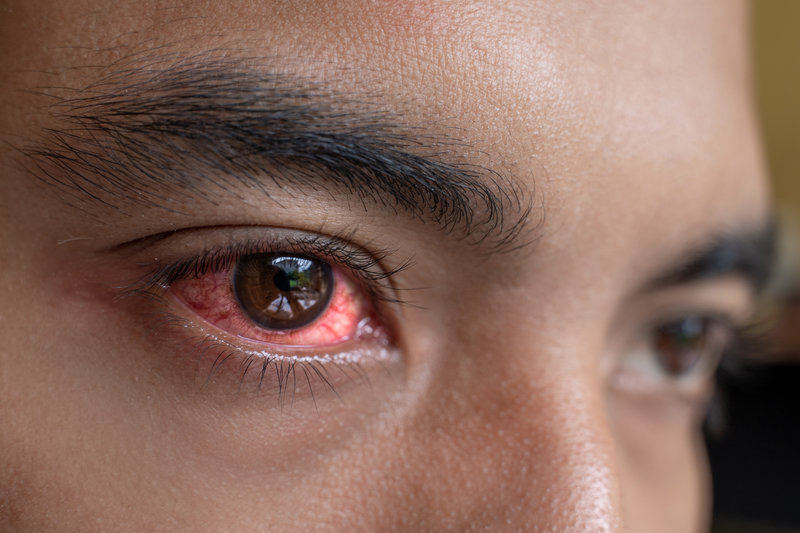Posted by: Atlantic Eye Institute in Education

Pink eye is a general term used to describe general eye infections (conjunctivitis) that affect the eye. It is also highly contagious. Doctors in China noticed that pink eye was another symptom of COVID-19. In some patients, doctors found evidence of the coronavirus in the eye discharge of patients with pink eye, meaning their tears and discharge had the potential to transmit the disease to others.
This is not surprising since the virus affects the respiratory system, and the eyes are connected to the upper portion of the sinuses through the nasolacrimal duct. As a result of this connection, any virus that affects that upper-respiratory system can potentially infect the eyes as well, and vice versa.
The Connection Between Pink Eye And COVID-19
We recently posted an article on COVID-19 and eye health. Click Here to read more about how protecting your eyes is another step to prevent contracting or spreading the virus.
What most people don’t realize is that the soft, permeable eye tissues are susceptible to viruses, including the coronavirus. So, if someone who is infected with the virus sneezes or coughs, and the droplets get into your eyes, you could become infected. If you touch an unsanitized doorknob/handle or grocery store product that was touched by someone who has the virus, and then you rub your eyes, you could become infected.
Similarly, if you or someone you love becomes infected with the coronavirus, pink eye could be a symptom of the virus, even if you don’t have any of the other, most typical symptoms (dry cough, fever, body aches, lack of smell/taste, etc.).
That said, pink eye is a very common eye infection, and most cases of pink eye are not COVID-19 infections. It is simply better to contact your eye doctor and err on the side of caution than to have a “wait and see” approach.
Symptoms Of Pink Eye: Do Not Ignore Them
Pink eye is caused by bacteria or viruses that infect vulnerable and susceptible eye tissues. Symptoms of pink eye include:
- Pink or red eyes (sometimes in one eye, but the infection often migrates to the other eye)
- Swollen conjunctiva (the membrane that covers the inner eyelids and the whites of the eye)
- Runny, watery eyes (excessive tearing)
- White, green, or yellowish discharge
- Waking up with eyes that are stuck together with discharge
- Itchy or painful eyes
- Blurred vision
If you or someone in your household has any of the above symptoms, contact your eye doctor. Most offices have a 24/7 care line to address patient concerns.
Your Eyes Are Linked To The Respiratory System
While the body has individual parts, we know that all of these parts are intricately connected. This includes your eyes and your sinuses (part of the upper respiratory system). The conjunctival sac is directly connected to the nasal cavity by the nasolacrimal duct.
While designed to allow for fluid and toxin drainage, this duct also allows bacteria and viral material to travel from the eyes to the nasal passage, or vice versa, especially if the body’s immune system is not up to par.
So, just as COVID-19 can potentially be transmitted from the eyes through the sinus channels, the virus can also operate in reverse. In the reverse model, the virus would spread from mucous or infected sinus tissues, through the bloodstream or nasolacrimal duct, allowing it to infect the conjunctiva.
How To Protect Your Eyes And Yourself From COVID-19
Here are steps to ensure you are protecting your eyes, yourself, and the community from the spread of COVID-19.
- Maintain social distancing (six to ten feet). Adhere to social distancing protocols, remaining at least six to ten feet from others when you are outside of the house. Do not leave your home if you are feeling under the weather or have symptoms of a cold or flu.
- Regularly wash hands for 20 seconds. Washing your hands with soap and water, for at least 20 seconds, is one of the best things we can all do to prevent the spread of the virus. Be vigilant with hand washing – especially before or after touching your face.
- Wear glasses instead of contacts. People who wear contacts are more apt to rub their eyes and more prone to eye infections. Wear your glasses to alleviate that risk during the pandemic, and enjoy their extra protection from potentially infected respiratory droplets.
- Contact your eye doctor ASAP if you have symptoms. If you or someone in your household has pink eye symptoms, contact your eye doctor for further instructions. If your pink eye is a symptom of COVID-19, you need immediate treatment.
Virtual Or Face-To-Face Care, We’ve Got You Covered
The team here at the Atlantic Eye Institute is excited that routine ophthalmic and optometric care has resumed in the state of Florida as of May 4th. We also understand if you’d prefer to use our virtual patient care platform. Contact us at (904) 241-7865 for 24/7 access to eye health support or you can request an appointment online.



